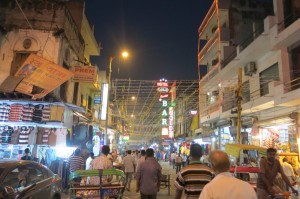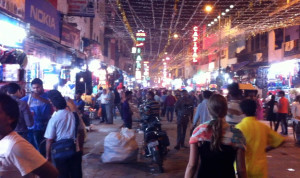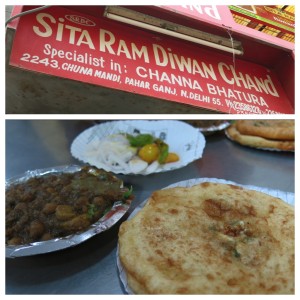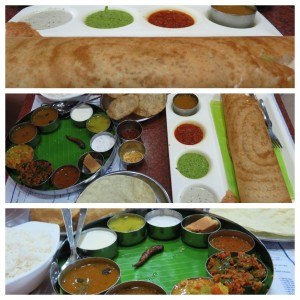Teach Me How to Delhi
by Dave
October 17 – 19
India.
Oh. My. Gosh.
This country.
India is… a lot. A lot of noise, a lot of pollution, a lot of smells, a lot of people. And just a lot to take in, especially after coming off Nepal and what could likely turn out to be the most peaceful part of our year. At the risk of sounding like a broken record, this was yet another place we didn’t expect to visit when we set off on this trip. Not because it didn’t geographically fit in with our route as much as it didn’t fit in with our acknowledged breaking points. We knew that a visit to India would be testing fate and likely just counting down the minutes until one of us would have a meltdown or just surrender to this in-your-face (most notably the nostrils and ears) country and society. But alas, we heard from so many people and read so many articles about how uniquely enthralling the place is and we ran out of excuses not to go.
But we made a bit of a compromise with India. We’d give it a visit, as long as it would let us out again with some level of dignity if we kept the visit to less than two weeks. And once we found out that October is one of the coolest times of year to visit (apparently highs in the 90s still qualify as “cool”), 11 days in northern India were booked and we were on our way. To be clear, we’re under no illusion that a trip that short would qualify us to give a completely accurate assessment of the country, but the following is just based on our observations while we were there.
For those of you that have been paying close attention, we typically book guesthouses, B&B’s and apartment rentals as we travel. In Delhi we made an exception and went with a hostel in the Pahar Ganj neighborhood (right near the border between Old and New Delhi), booking a room at the pleasantly and surprisingly clean and livable Smyle Inn which became a respite to retire to at the end of our exhausting days. Our stay included airport taxi pick-up service (always a plus), so our first exposure to Delhi was being thrown right into its notoriously notorious traffic.
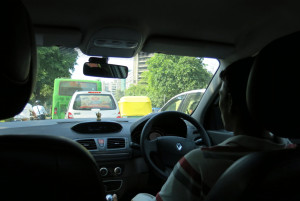
While not the best photo, you’ll notice that from inside our car you can see us surrounded by a bus, an SUV, another sedan, a tuk-tuk and two motorcycles weaving through it all.
Here, lane lines and speed limits are mere suggestions rather than laws. Changing speeds constantly, we were in four-wide traffic on a two-lane road. Had we tried, we could have easily been shaking hands with drivers and passengers from the other cars without even slightly straining ourselves to lean forward in our seats.
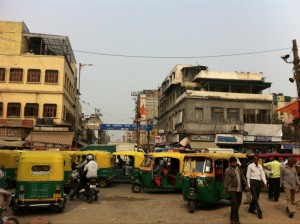
Despite the fact that you cannot see through all the tuk-tuks and pedestrians, I promise this was at a 4-way intersection.
And forget shutting your eyes and trying to doze off to take your mind off the traffic – the honking of horns is inescapable. Many cars and trucks (typically the ones without side-view mirrors) displayed bumper stickers asking you to honk your horn to let them know you’re there.
Honking your horn is more of a non-verbal conversation tactic than an aggressive act like it’s typically perceived in the States. More of a “Hey, how ya doin’? Say hi to you mother for me,” than a “Are you serious? Get the f out of my way!!!” I don’t even know if road rage exists here despite the fact that the conditions bring together all the finest ingredients for it.
Another thing you can help but notice after even a small amount of time in the country is that there is a large divide between the “haves” and “have nots,” and nowhere can you see the dichotomy better than from the clogged streets and allies. You can be stuck in a traffic jam like we were on our first ride and see a Mercedes limousine with only a couple people stretched out in back rubbing bumpers with open-air tuk-tuks, bicycle rickshaws, ox carts and motorbikes, all while watching a family of four riding perilously on a two-person motorcycle. And then in your periphery you’ll glimpse a small community of makeshift tents set up under an underpass where friends and family crowd around a pot of food, almost oblivious to the congestion on the streets surrounding them.
So right from the jump, we could tell this would be unlike anywhere else we had been. As a whole, the country supports over 1.2 BILLION people. Yes, billion – nearly 1 billion more than the United States. We’re talking about a place with about four times as many people as the U.S. even though it’s just barely over 1/3 the size of America in land mass. Think about that.
We would explore Agra, Udaipur and Jodhpur during our week and a half in the region (more to come soon on those cities), but as I mentioned we started in Delhi, a city of just under 10 million people crammed into the amount of space that seemed to us like it would comfortably fit half that.
A good illustration of this crazy crush of people could be seen as we traversed the city by car (full disclosure: in an air-conditioned, chauffeured car loaned generously from my dad’s Delhi colleague, Mohan). During one leg of our tour it took us about 2.5 hours to travel between two major landmarks – mind you, they’re only 10 miles apart… so, yeah. But the long travel times were worth it as we got to check out four of the notable landmarks around the city – India Gate, Red Fort, Akshardham Temple and Lotus Temple.
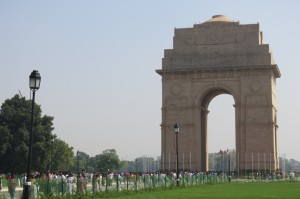
We started at India Gate. This 42 meter high Arc-de-Triomphe-esque structure was built to commemorate the lives of the 70,000 Indian soldiers that died fighting for the British Army during World War I. The names of all the soldiers are etched into the structure, and it also sports an eternal flame.
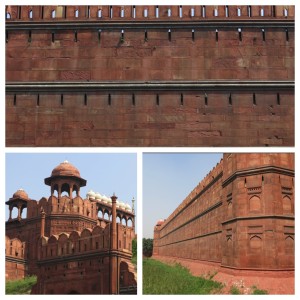
Red Fort, built by the same Mughal Emperor who commissioned the Taj Mahal, is pretty imposing from the exterior.

A couple shots of the interior show how it was more of a mix of parks, temples and living quarters. Slightly different than the blanket-covered chairs and playrooms that inhabited the forts I built many years ago…
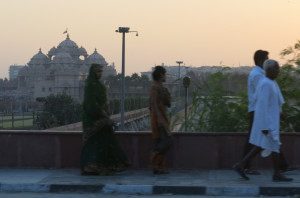
If ever there were a time that we could say “the pictures don’t do it justice” or “you had to be there” this would be it. But alas, the Akshardham Temple is the one place we’ve been where photos and cameras are checked at the door. The impressive temple opened eight short years ago as the World’s Largest Comprehensive Hindu Temple. While that sounds somewhat subjective, comprehensive is definitely a fitting term. The craftsmanship is unbelievable and we wished we had more time to spend there relaxing after walking around the grounds.

Another shot from the road. You’ll just have to trust us, the main temple and surrounding corridors and walkways and manmade ponds were built with an unbelievable attention to detail. We still are yet to visit the Temples of Angkor in Cambodia, but we felt like this was a modern version of those on a smaller scale. Very cool place.
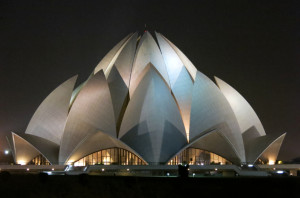
And finally, Lotus Temple. Again taken from a distance, since the 2.5hr commute to arrive here unfortunately ended just as they shut the gates for the day. Still impressive form afar, the entire structure is built from marble to look like a lotus flower.
And yet despite all the traffic and all the inconveniences we ran into, you can’t help but embrace many of the people and appreciate the living conditions and surroundings they’re dealing with. Noelle and I have both been fortunate to come from pretty comfortable upbringings where we were never worried about having food on the table and a pillow to lay our heads on at night. It’s easy to take those things for granted, but get a swift kick of reality when, for example, you go down to reception at your hostel to request an extra pillow and notice the receptionist sleeps overnight in the lobby on the hard floor. You begin to appreciate the work ethic of people who may cause frustration with certain things lost in translation when you realize they are always willing to help out however they can (not surprising in a country where the work week is six days instead of five). And like the conversational horn honking in traffic, the same goes for crowded streets and sidewalks on foot. It can be a total jam in certain spots, but it’s just the way it is and everyone remains calm. Many friends just stick together by holding hands, regardless of age or sex (whereas at home, two grown men holding hands would turn heads for many passersby). Of course, some may be more than friends, but it was clear in many cases, their passion for everything (talking loudly, spicy food, LED lights) spilled over to friendships as well.
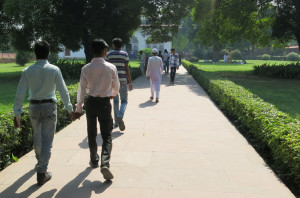
As we saw just about everywhere, it’s not uncommon for two friends to hold hands to stick together while out in public. Kinda nice to see actually.
And just when you think everything is too much to handle, India goes and TOTALLY redeems itself. I’m talking about the food. It’s amazing. All of it. Everywhere. Whether it was in the not-to-be-forgotten lunch at Sita Ram Diwan Chand (say that 10 times fast) of chole bhature (the “chole” being a spicy chick pea mix, and “bhature” being the fried bread you spread it onto) where you can fill up for less than a couple dollars per person, or the endless choices of curries, naans, soups, dumplings, etc. that overwhelm you (in the best way) with the flavors and seasonings, the food didn’t let us down (Side note: we avoided street food as a general guideline, so if we had not done that I’d likely not be saying the “didn’t let us down” part because of a bout with Delhi Belly).
We got an even closer look at authentic Indian cuisine on our visit to Mohan’s home, when he invited us not once, but twice, to dine with his family.
Our first go-round came at the end of our day touring the city with the help of his private driver (as if that wasn’t generous enough), where we were treated to one of our better meals during our time in India, a mix of home-cooked deliciousness from Mohan’s mother-in-law to give us a taste of what typical south Indian cuisine is like (since the family is from the southern state of Kerala). Naturally I’ve forgotten the names of some of the dishes, but fish curries, grilled chicken, multiple types of rice and some sort of coconut-based spicy paste abounded. Oh, and there was a rice pudding that tasted like Fruity Pebbles. So that did not suck. And to top that off, we were welcomed back on our last day in the country before our departure flight out of Delhi, and once again were given the royal treatment with another amazing spread of food that was impossible to turn down when our new favorite Indian chef kept asking us if we wanted extra helpings. (EDITOR’S NOTE: Dave quickly became the adopted favorite of the sassy saucier due to his penchant for seconds. She called him her “son” and repeatedly asked him to return soon. Sibling rivalry kicked in, but maturity trumped my infantile instinct to start tap dancing for attention. Okay, fine. There was ONE shuffle-ball-change.)
Sure, India has its drawbacks, and they will rear their head at you if you don’t know they’re coming (EDITOR’S NOTE: Which, really, no one would blame you for because it’s impossible to truly imagine until you’re in the middle of the street dodging between the cows, throngs of people and vehicles, debris piles and the man using the sidewalk as his own personal restroom). But there is something intoxicating about the place that gives it a dangerously addictive quality. So as happy as I am to have returned to a slower pace of our day-to-day life, I can’t separate myself from the urge to just really want to go back.



